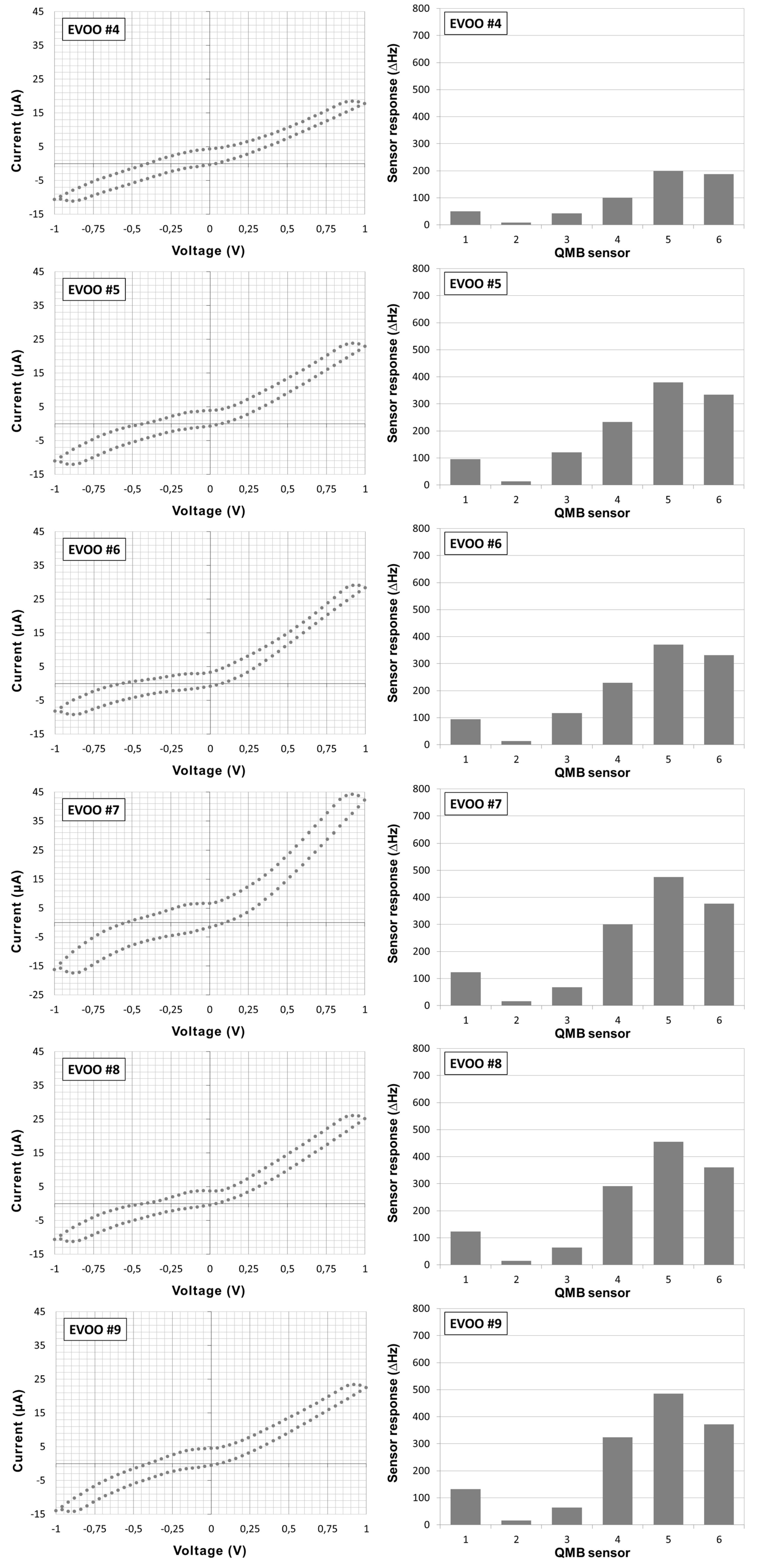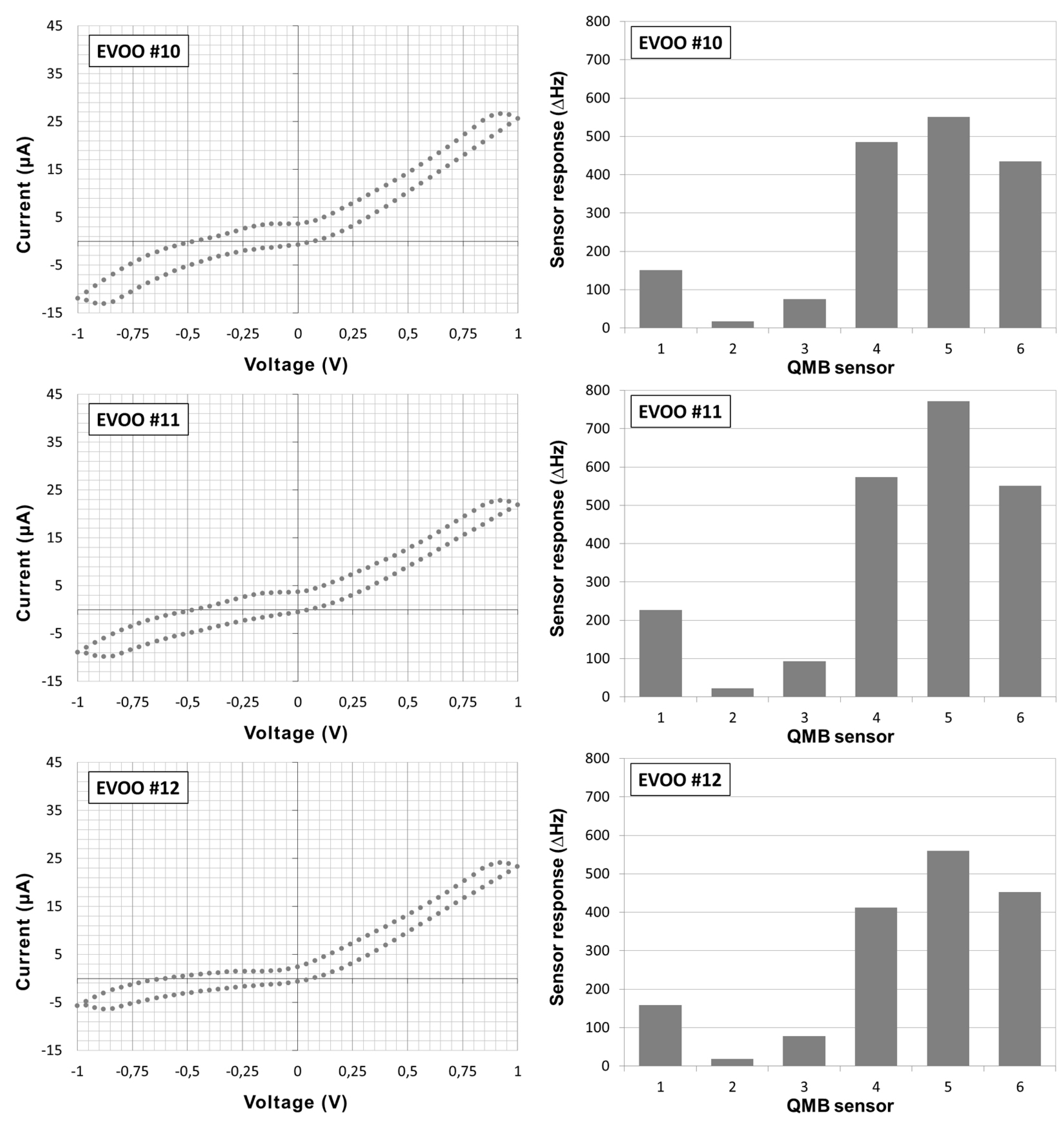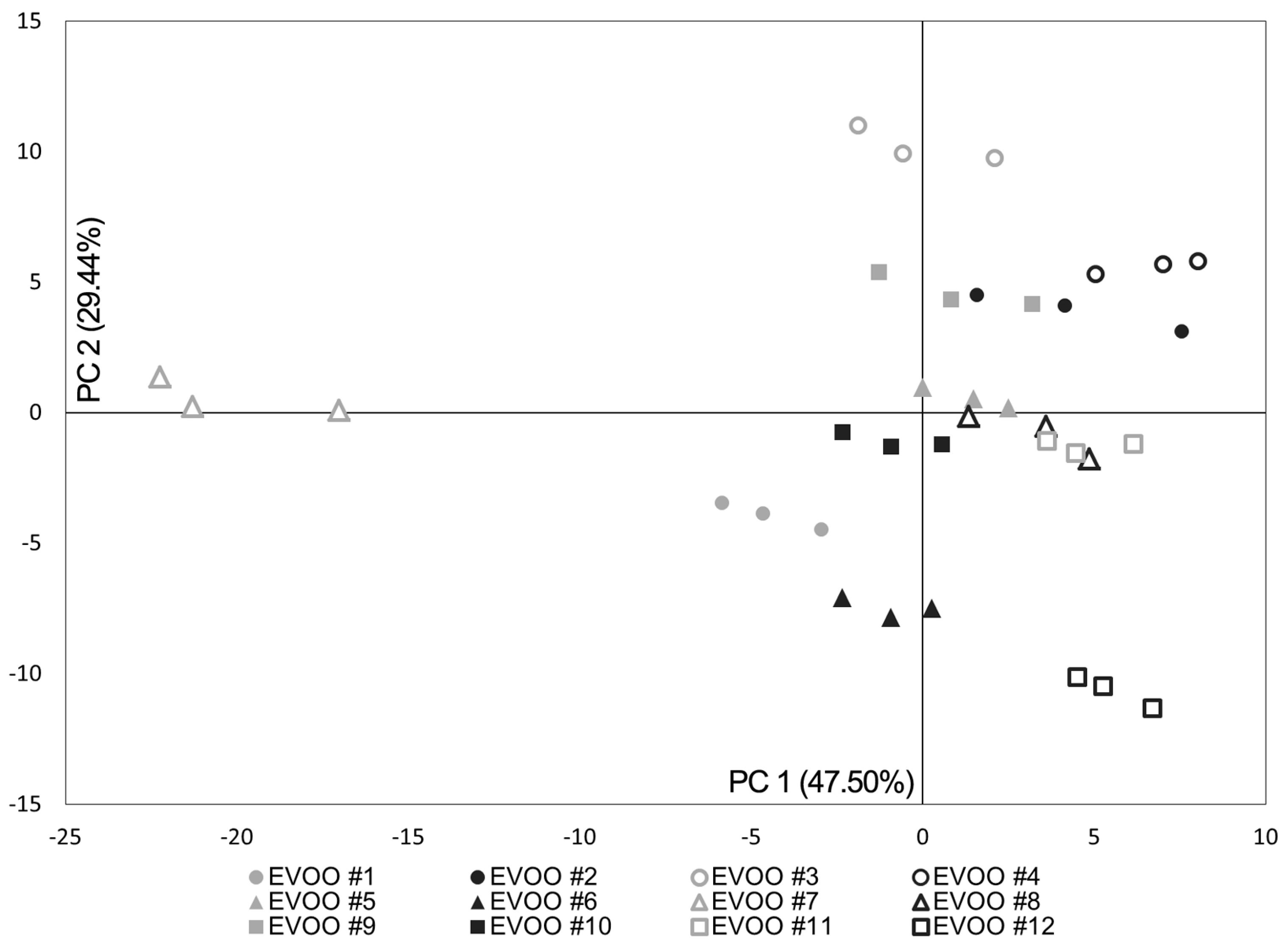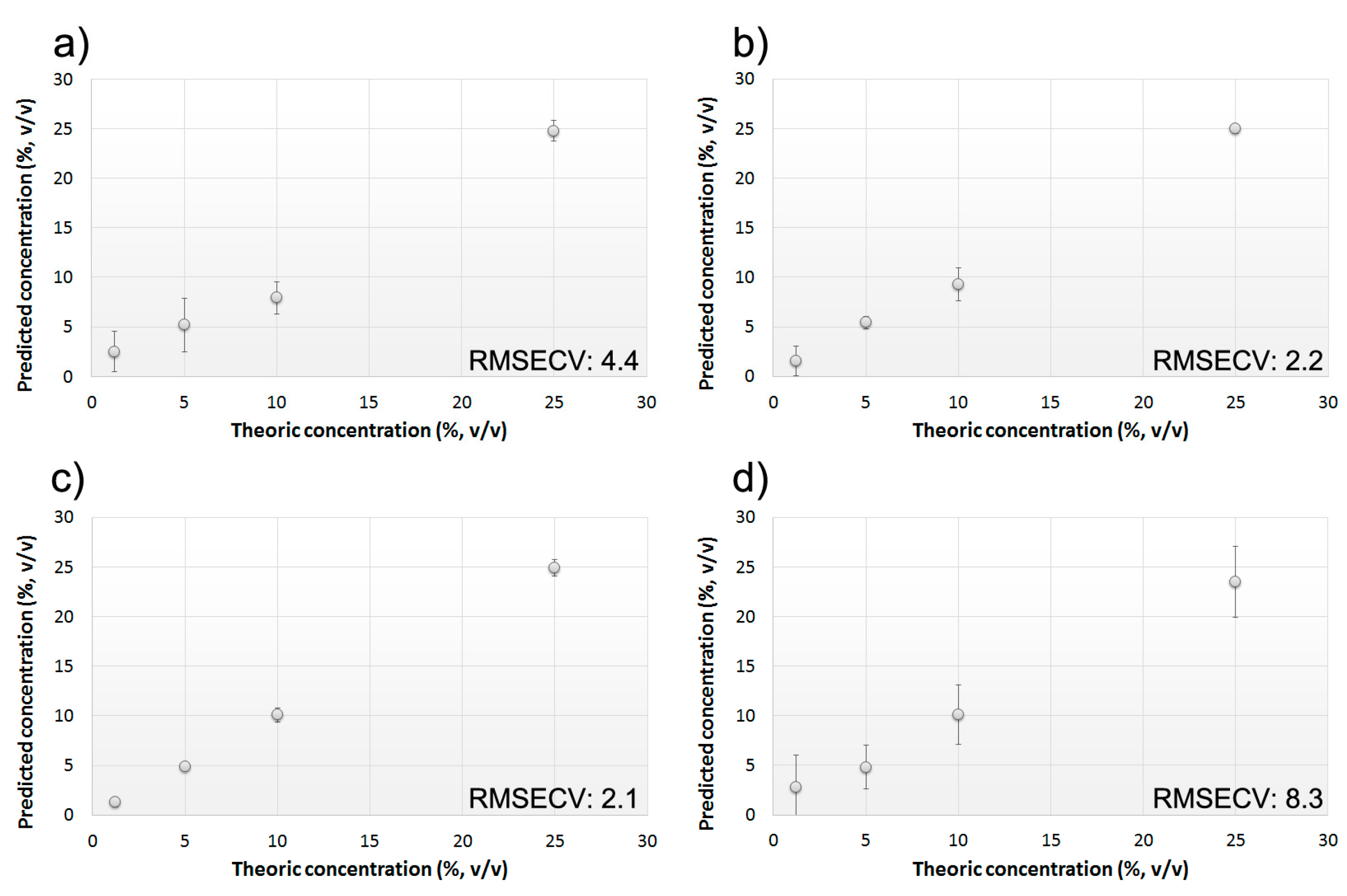Unmasking of Olive Oil Adulteration Via a Multi-Sensor Platform
Abstract
:1. Introduction
2. Materials & Methods
2.1. Oil Samples
| Oil Sample | Geographical Origin | Year of Production | Oil Variety |
|---|---|---|---|
| EVOO #1 | Laterba | 2013/2014 | Picoline |
| EVOO #2 | Castellaneta | 2013/2014 | Leccino |
| EVOO #3 | Laterba | 2013/2014 | Picoline (organic) |
| EVOO #4 | Laterba | 2013/2014 | Arbequina (organic) |
| EVOO #5 | Grottaglie and Crispiano | 2013/2014 | Picoline (50%), Nociara (35%), Leccino (15%) |
| EVOO #6 | Crispiano | 2013/2014 | Leccino |
| EVOO #7 | Grottaglie | 2013/2014 | Ogliarola |
| EVOO #8 | Grottaglie | 2013/2014 | Picoline |
| EVOO #9 | Grottaglie | 2012/2013 | Cellina di Nardò |
| EVOO #10 | Laterba | 2013/2014 | Leccino |
| EVOO #11 | Crispiano | 2012/2013 | Cellina di Nardò |
| EVOO #12 | Crispiano | 2012/2013 | Cima di Melfi |
2.2. Gas Analysis
2.3. Liquid Analysis
2.4. Chemical Quality Control Analyses
2.5. Data Analysis
3. Results
3.1. Olive Oil BIONOTE Characterization




3.2. Olive Oil Chemical Characterization
| Oil Sample | Free Acidity (mg/100 g Oleic Acid) | Peroxide Value (mEq O2/Kg) | ∆K | Refractive Index |
|---|---|---|---|---|
| EVOO #1 | 3.4 ± 0.1 | 15.0 ± 0.4 | 0.0020 | 1.469 |
| EVOO #2 | 3.4 ± 0.1 | 12.2 ± 0.1 | 0.0045 | 1.468 |
| EVOO #3 | 4.9 ± 0.2 | 6.0 ± 0.1 | 0.0065 | 1.468 |
| EVOO #4 | 2.0 ± 0.1 | 6.9 ± 0.1 | 0.0015 | 1.467 |
| EVOO #5 | 7.3 ± 0.1 | 8.7 ± 0.1 | 0.0015 | 1.468 |
| EVOO #6 | 6.0 ± 0.1 | 9.5 ± 0.3 | 0.0005 | 1.467 |
| EVOO #7 | 5.3 ± 0.1 | 7.2 ± 0.4 | 0.0030 | 1.467 |
| EVOO #8 | 4.3 ± 0.2 | 18.1 ± 0.2 | 0.0045 | 1.468 |
| EVOO #9 | 2.8 ± 0.1 | 9.9 ± 0.2 | 0.0035 | 1.468 |
| EVOO #10 | 3.9 ± 0.1 | 13.5 ± 0.4 | 0.0015 | 1.467 |
| EVOO #11 | 6.1 ± 0.2 | 9.4 ± 0.5 | 0.0030 | 1.467 |
| EVOO #12 | 3.1 ± 0.2 | 9.9 ± 0.3 | 0.0160 | 1.467 |
3.3. Olive Oil Adulteration

3.4. BIONOTE Relevance to the Chemical Parameters

4. Discussion
5. Conclusions
Author Contributions
Conflicts of Interest
References
- International Olive Council (IOC). Trade Standards Applying to Olive Oils and Olive-Pomace Oils; COI/T.15/NC No 3/Rev. 7; International Olive Council (IOC): Madrid, Spain, 2013. [Google Scholar]
- European Communities (EC). Commission Implementing Regulation (EU) No 1348/2013. Official Journal of the European Union (Regulation No 1348/2013 L338/31, 16 December 2013). Available online: http://www.beuth.de/en/regulation/euv-1348-2013/200370127 (accessed on 28 August 2015).
- Aparicio, R.; Harwood, J. Handbook of Olive Oil Analysis and Properties, 2nd ed.; Springer: New York, NY, USA, 2013. [Google Scholar]
- Angerosa, F.; Campestre, C.; Giansante, G. Analysis and authentication. In Olive Oil: Chemistry and Technology, 2nd ed.; AOCS Publishing: New York, NY, USA, 2006. [Google Scholar]
- Gómez-Rico, A.; Salvador, M.D.; Moriana, A.; Pérez, D.; Olmedilla, N.; Ribas, F.; Fregapane, G. Influence of different irrigation strategies in a traditional cornicabra cv. Olive orchard on virgin olive oil composition and quality. Food Chem. 2007, 100, 568–578. [Google Scholar] [CrossRef]
- Harwood, J.L.; Yaqoob, P. Nutritional and health aspects of olive oil. Eur. J. Lipid Sci. Technol. 2002, 104, 685–697. [Google Scholar] [CrossRef]
- Kamal-Eldin, A.; Moreau, R.A. Gourmet and Health-Promoting Specialty Oils; AOCS Publishing: New York, NY, USA, 2009. [Google Scholar]
- Zhang, J.; Zhang, X.; Dediu, L.; Victor, C. Review of the current application of fingerprinting allowing detection of food adulteration and fraud in china. Food Control 2011, 22, 1126–1135. [Google Scholar] [CrossRef]
- Aparicio, R.; Aparicio-Ruiz, R.; García-González, D.; van Amerongen, A.; Barug, D.; Lauwars, M. Rapid methods for testing of oil authenticity: The case of olive oil. Rapid Methods 2007, 10, 163–188. [Google Scholar]
- Aparicio, R.; Morales, M.T.; Aparicio-Ruiz, R.; Tena, N.; García-González, D.L. Authenticity of olive oil: Mapping and comparing official methods and promising alternatives. Food Res. Int. 2013, 54, 2025–2038. [Google Scholar] [CrossRef]
- American Oils Chemists’ Society (AOCS). Determination of Fatty Acids in Olive Oils by Capillary GLC; Official Method Ch 2–91; American Oils Chemists’ Society (AOCS): New York, NY, USA, 2009. [Google Scholar]
- International Olive Council (IOC). Determination of Trans-Unsaturated Fatty Acids by Capillary Column Gas Chromatography; COI/T.20/Doc. No 17/Rev. 1; International Olive Council (IOC): Madrid, Spain, 2001. [Google Scholar]
- International Olive Council (IOC). Determination of Wax Content by Capillary-Column Gas Chromatography; COI/T.20/Doc. No 18; International Olive Council (IOC): Madrid, Spain, 2003. [Google Scholar]
- International Olive Council (IOC). Determination of Aliphatic Alcohols Content by Capillary Gas Chromatography; COI/T.20/Doc. No 26; International Olive Council (IOC): Madrid, Spain, 2003. [Google Scholar]
- International Olive Council (IOC). Determination of the Composition and Content of Sterols and Triterpene Dialcohols by Capillary Column Gas Chromatography; COI/T.20/Doc. No 30; International Olive Council (IOC): Madrid, Spain, 2013. [Google Scholar]
- Santonico, M.; Pennazza, G.; Grasso, S.; Amico, A.; Bizzarri, M. Design and test of a biosensor-based multisensorial system: A proof of concept study. Sensors 2013, 13, 16625–16640. [Google Scholar] [CrossRef] [PubMed]
- Singleton, V.L.; Rossi, J.A. Colorimetry of total phenolics with phosphomolybdic-phosphotungstic acid reagents. Am. J. Enol. Vitic. 1965, 16, 144–158. [Google Scholar]
- American Oils Chemists’ Society (AOCS). Acid Value; Official Method Cd 3d-63; American Oils Chemists’ Society (AOCS): New York, NY, USA, 2009. [Google Scholar]
- American Oils Chemists’ Society (AOCS). Peroxide Value Acetic Acid-Isooctane Method; Official Method Ch Cd 8b-90; American Oils Chemists’ Society (AOCS): New York, NY, USA, 2011. [Google Scholar]
- American Oils Chemists’ Society (AOCS). Determination of Specific Extinction of Oils and Fats, Ultraviolet Absorption; Official Method Ch 5–91; American Oils Chemists’ Society (AOCS): New York, NY, USA, 2009. [Google Scholar]
- García-González, D.L.; Aparicio, R. Research in olive oil: Challenges for the near future. J. Agric. Food Chem. 2010, 58, 12569–12577. [Google Scholar] [CrossRef] [PubMed]
- International Olive Council (IOC). Global Method for the Detection of Extraneous Oils in Olive Oils; COI/T.20/Doc. No. 25; International Olive Council (IOC): Madrid, Spain, 2006. [Google Scholar]
- Mignani, A.G.; García-Allende, P.B.; Ciaccheri, L.; Conde, O.M.; Cimato, A.; Attilio, C.; Tura, D. Comparative Analysis of Quality Parameters of Italian Extra Virgin Olive Oils According to Their Region of Origin. In Proceedings of the SPIE, San Francisco, CA, USA, 3 March 2008.
- Agiomyrgianaki, A.; Petrakis, P.V.; Dais, P. Detection of refined olive oil adulteration with refined hazelnut oil by employing nmr spectroscopy and multivariate statistical analysis. Talanta 2010, 80, 2165–2171. [Google Scholar] [CrossRef] [PubMed]
- Calvano, C.D.; Ceglie, C.D.; D’Accolti, L.; Zambonin, C.G. Maldi-tof mass spectrometry detection of extra-virgin olive oil adulteration with hazelnut oil by analysis of phospholipids using an ionic liquid as matrix and extraction solvent. Food Chem. 2012, 134, 1192–1198. [Google Scholar] [CrossRef] [PubMed]
- Chiavaro, E.; Vittadini, E.; Rodriguez-Estrada, M.T.; Cerretani, L.; Bendini, A. Differential scanning calorimeter application to the detectionof refined hazelnut oil in extra virgin olive oil. Food Chem. 2008, 110, 248–256. [Google Scholar] [CrossRef] [PubMed]
- Maggio, R.M.; Cerretani, L.; Chiavaro, E.; Kaufman, T.S.; Bendini, A. A novel chemometric strategy for the estimation of extra virgin olive oil adulteration with edible oils. Food Control 2010, 21, 890–895. [Google Scholar] [CrossRef]
- Poulli, K.I.; Mousdis, G.A.; Georgiou, C.A. Rapid synchronous fluorescence method for virgin olive oil adulteration assessment. Food Chem. 2007, 105, 369–375. [Google Scholar] [CrossRef]
- Apetrei, C.; Apetrei, I.M.; Villanueva, S.; de Saja, J.A.; Gutierrez-Rosales, F.; Rodriguez-Mendez, M.L. Combination of an e-nose, an e-tongue and an e-eye for the characterization of olive oils with different degree of bitterness. Anal. Chim. Acta 2010, 663, 91–97. [Google Scholar] [CrossRef] [PubMed]
- Cosio, M.S.; Ballabio, D.; Benedetti, S.; Gigliotti, C. Geographical origin and authentication of extra virgin olive oils by an electronic nose in combination with artificial neural networks. Anal. Chim. Acta 2006, 567, 202–210. [Google Scholar] [CrossRef]
- Escuderos, M.E.; Sánchez, S.; Jiménez, A. Virgin olive oil sensory evaluation by an artificial olfactory system, based on quartz crystal microbalance (QCM) sensors. Sens. Actuators B Chem. 2010, 147, 159–164. [Google Scholar] [CrossRef]
- Haddi, Z.; Alami, H.; El Bari, N.; Tounsi, M.; Barhoumi, H.; Maaref, A.; Jaffrezic-Renault, N.; Bouchikhi, B. Electronic nose and tongue combination for improved classification of moroccan virgin olive oil profiles. Food Res. Int. 2013, 54, 1488–1498. [Google Scholar] [CrossRef]
© 2015 by the authors; licensee MDPI, Basel, Switzerland. This article is an open access article distributed under the terms and conditions of the Creative Commons Attribution license (http://creativecommons.org/licenses/by/4.0/).
Share and Cite
Santonico, M.; Grasso, S.; Genova, F.; Zompanti, A.; Parente, F.R.; Pennazza, G. Unmasking of Olive Oil Adulteration Via a Multi-Sensor Platform. Sensors 2015, 15, 21660-21672. https://doi.org/10.3390/s150921660
Santonico M, Grasso S, Genova F, Zompanti A, Parente FR, Pennazza G. Unmasking of Olive Oil Adulteration Via a Multi-Sensor Platform. Sensors. 2015; 15(9):21660-21672. https://doi.org/10.3390/s150921660
Chicago/Turabian StyleSantonico, Marco, Simone Grasso, Francesco Genova, Alessandro Zompanti, Francesca Romana Parente, and Giorgio Pennazza. 2015. "Unmasking of Olive Oil Adulteration Via a Multi-Sensor Platform" Sensors 15, no. 9: 21660-21672. https://doi.org/10.3390/s150921660
APA StyleSantonico, M., Grasso, S., Genova, F., Zompanti, A., Parente, F. R., & Pennazza, G. (2015). Unmasking of Olive Oil Adulteration Via a Multi-Sensor Platform. Sensors, 15(9), 21660-21672. https://doi.org/10.3390/s150921660









